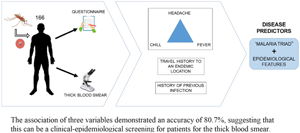Article contents
Analysis of malaria clinical−epidemiological predictors in individuals from Brazilian Amazon
Published online by Cambridge University Press: 05 July 2021
Abstract

This research aims to determine whether the combination of epidemiological and clinical features can predict malaria. Diagnostic investigation detected 22.3% of individuals with Plasmodium vivax (P. vivax) malaria, with significant predominance of the male gender. The malaria triad (fever, chills and headache) had a more expressive frequency (81.1%) in individuals with positive thick blood than those with negative thick blood smear (65.1%), although there was no statistical significance. Among the variables analysed as predictive for positive thick blood smear, it was observed that personal history of travel to an endemic malaria area and past malaria infection (PMI) were significantly associated with malaria, even in multiple logistic regression. Fever had the higher sensitivity (94.6%) and past malaria history had the greater specificity (68.2%), with accuracy of 23.5% and 67.5%, respectively. In combined analysis, fever with chills had the highest sensitivity (91.9%), but low accuracy (38.5%). High specificity (91.5%) was found in the association of malaria triad, PMI and history of travel to endemic malaria area (which along with anorexia, was higher 94.6%), with good accuracy (80.7%), suggesting that the screening of patients for performing thick blood smear can be based on these data. The epidemiological features and the malaria triad (fever, chills and headache) can be predictors for identification of malaria patients, concurring to precocious diagnosis and immediate treatment of individuals with malaria.
- Type
- Research Article
- Information
- Copyright
- Copyright © The Author(s), 2021. Published by Cambridge University Press
References
- 1
- Cited by



